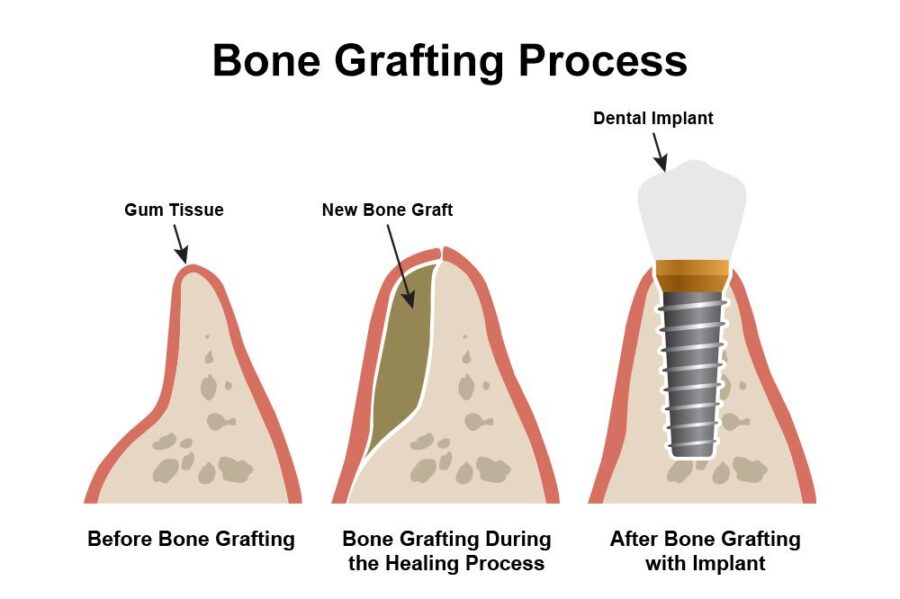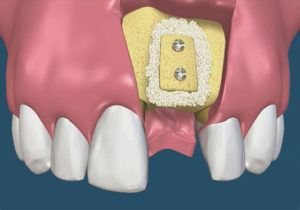Dental implants are a great method to replace lost teeth, but they aren’t always an option. When there isn’t enough bone in the jaw to support an implant, bone grafting may be necessary to create a stable foundation for tooth. At Royal Dental Clinics, we offer advanced dental implant services and bone grafting procedures. In this article, we’ll take a closer look at the reasons why bone grafting may be necessary, and how it can increase the success of dental implant procedures. Whether you’re considering dental implants for yourself or simply interested in learning more about the science behind this innovative dental solution, read on to discover the fascinating world of dental implantology.
Need for Bone Grafting in Dental Implant Surgery
Before we dive into the science behind bone grafting and dental implants, let’s first understand why bone grafting may be necessary in the first place. In order for dental implants to be successful, they need to be securely anchored into the jawbone. For some individuals, however, there may not be enough natural bone in the jaw to support the implant. This can be due to a variety of factors, including trauma, periodontal disease, or simply a lack of bone density.
Without sufficient bone to anchor the implant, the procedure is unlikely to be successful. This is where bone grafting comes in. By adding bone to the jaw, either from another part of the body or from a synthetic or animal source, a solid foundation can be created for the implant to be placed. This not only increases the success rate of the procedure but can also improve the overall aesthetic result, as the implant will be positioned correctly and securely.
Understanding Bone and Grafting Regeneration
To understand how bone grafting works, it’s important to first understand a bit about bone physiology and regeneration. Bone is a living tissue that is constantly being broken down and rebuilt. This process is known as bone remodeling and is controlled by a complex interplay of hormones, growth factors, and cells. When bone is broken or damaged, the body sends signals to activate bone remodeling and repair the damage. This process involves the recruitment of cells called osteoblasts, which lay down new bone tissue, and osteoclasts, which break down and remove old bone tissue.

When a bone graft is performed, the goal is to stimulate this natural process of bone regeneration. The added bone acts as a scaffold or matrix, providing a surface for new bone cells to attach and grow. Over time, the added bone is integrated into the existing bone, creating a solid foundation for the dental implant.
Types of Bone Grafting Materials
Autografts: Autografts are the gold standard of bone grafting materials as they are taken from the patient’s own body. The most common donor site for autografts is the iliac crest, which is located at the top of the pelvic bone. Autografts have several advantages, including high success rates, rapid healing, and low risk of disease transmission or immune rejection.
Allografts: Allografts are bone grafts that come from a donor, typically from a cadaver. The bone is processed and sterilized to remove all cells and prevent disease transmission. Allografts are readily available and eliminate the need for a second surgical site. They are commonly used for reconstructive surgery, spinal fusion, and dental implants.

Xenografts: Xenografts are bone grafts that come from a different species, such as a cow or a pig. The bone is processed and sterilized to remove all cells and prevent disease transmission. Xenografts are readily available and eliminate the need for a second surgical site. They are commonly used in dental implants and orthopedic surgeries.
Synthetic Bone Grafts: Synthetic bone grafts are made from biocompatible materials such as calcium phosphate, hydroxyapatite, and tricalcium phosphate. They are designed to mimic the structure and composition of natural bone and promote new bone growth. Synthetic bone grafts are commonly used in dental implants, spinal fusion, and orthopedic surgeries.
Bone Grafting Procedures for Dental Implants
Initial consultation
During your initial consultation, Dr. Chamria will examine your teeth, gums, and jawbone to determine if you are a good candidate for dental implant surgery. He will also discuss your medical history, any medications you are taking, and your goals for the procedure.
CT scan and 3D imaging
Doctors will use advanced imaging technologies such as CT scans and 3D imaging to evaluate the density and volume of your jawbone and identify any areas of bone loss that may require bone grafting.
Bone grafting procedure
Depending on the severity of the bone loss, Dr. Chamria may perform one of several bone grafting procedures, including:
✦ Socket preservation: This procedure involves placing bone grafting material into the empty socket after a tooth extraction to prevent bone loss and prepare the area for dental implant placement.
✩ Sinus lift: A sinus lift involves adding bone grafting material to the upper jawbone to increase the height of the bone and provide adequate support for dental implants.
✦ Ridge augmentation: This procedure involves adding bone grafting material to the jawbone to increase the width and height of the ridge and create a more stable foundation for dental implants.
Healing and recovery
After the bone grafting procedure, it can take several months for the new bone to integrate with the existing bone and create a solid foundation for dental implants. Dr. Chamria will monitor your progress and provide you with instructions on how to care for your mouth during the healing process.
Dental implant placement
Once the bone has fully healed, Dr. Chamria will place the dental implant(s) into the jawbone. The implant(s) will fuse with the surrounding bone over time, creating a strong and stable foundation for the replacement tooth.
Factors Affecting Bone Grafting Success
Type of bone grafting material: The success of a bone grafting procedure depends on the type of material used to replace or regenerate the lost bone. The most commonly used materials include autografts (bone taken from the patient’s own body), allografts (bone taken from a donor), and synthetic bone substitutes. Each material has its own advantages and disadvantages, and the choice of material will depend on the individual patient’s needs and circumstances.
Quantity and quality of existing bone: The success of a bone grafting procedure depends on the quantity and quality of the existing bone in the area where the graft will be placed. If there is not enough existing bone or the bone is of poor quality, the graft may not be able to integrate properly, leading to implant failure or other complications.
Patient’s overall health: The patient’s overall health and medical history can also impact the success of a bone grafting procedure. Patients who have conditions such as diabetes or osteoporosis may have a higher risk of implant failure, and may require additional treatment or longer healing times.
Surgical technique: The surgical technique used to perform the bone grafting procedure can also impact the success of the procedure. The surgeon’s skill and experience, as well as the use of advanced surgical technologies, can help to ensure that the graft is placed correctly and heals properly.
Smoking and other lifestyle factors: Lifestyle factors such as smoking, excessive alcohol consumption, and poor nutrition can also impact the success of a bone grafting procedure. Smoking, in particular, can impair the body’s ability to heal and increase the risk of implant failure.
Risks and Complications of Bone Grafting
Infection: The risk of infection is present with any surgical procedure, including bone grafting. In some cases, infections can be treated with antibiotics, but in more severe cases, additional surgery may be required.
Bleeding: Some bleeding is normal after a bone grafting procedure, but excessive bleeding can be a sign of a complication. Patients may be advised to avoid certain medications or foods that can increase the risk of bleeding.
Nerve damage: Nerves in the surrounding areas can be damaged during the bone grafting procedure, leading to numbness, tingling, or loss of sensation. In most cases, nerve damage is temporary, but in rare cases, it can be permanent.
Rejection of graft material: There is a small risk that the body may reject the graft material, leading to implant failure or other complications.
Graft failure: In some cases, the graft material may not integrate properly with the existing bone, leading to graft failure and the need for additional surgery.
Sinus complications: If bone grafting is performed in the upper jaw, there is a risk of sinus complications, including sinus infections or perforation of the sinus membrane.
Allergic reactions: Rarely, patients may have an allergic reaction to the bone graft material, leading to complications.
Recovery after Implant Surgery with Bone Grafting
Dental implant surgery with bone grafting is a complex procedure that requires a significant amount of healing time and aftercare to ensure optimal results. Here are some of the key factors that contribute to a successful recovery and aftercare process:
Rest and Recovery: It is essential to allow the body to rest and heal following a dental implant surgery with bone grafting. Patients are advised to rest for at least 24-48 hours after the procedure, avoiding any strenuous activities or exercise.
Pain Management: Pain and discomfort are common after dental implant surgery with bone grafting. Patients will be prescribed pain medication to manage any discomfort during the recovery period.
Oral Hygiene: Good oral hygiene is essential for preventing infection and ensuring the success of the dental implant procedure. Patients will be advised to avoid brushing or flossing the surgical area for the first few days after surgery, but will need to resume their regular oral hygiene routine as soon as possible. A gentle, soft-bristled toothbrush should be used to avoid irritating the surgical site.
Diet: Patients will need to modify their diet during the recovery period, focusing on soft, easy-to-chew foods that are nutrient-rich. Hard, crunchy, or sticky foods should be avoided for the first few weeks after surgery.
Follow-Up Appointments: Regular follow-up appointments with the dentist or oral surgeon are essential to monitor the healing process and ensure the dental implant and bone graft are integrating properly. These appointments will also provide an opportunity to identify any potential complications and take corrective action as needed.
Avoiding Pressure on the Surgical Site: Patients should avoid putting any pressure on the surgical site, such as by touching or rubbing it, as this can interfere with the healing process.
Conclusion
While dental implants are a permanent remedy for tooth loss, bone grafting may be required for proper implant placement. Our highly trained staff at Royal Dental Clinics use cutting-edge equipment and methods to give exceptional dental health services. We can answer your concerns and help you make an informed decision regarding dental implants and bone grafting. To arrange a meeting, please get in touch with us right away.






